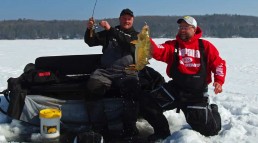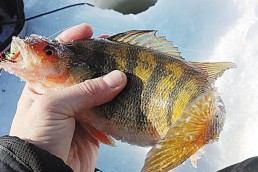Safety on the Ice: Basics, Basic Gear, Safe Practices
SHARE THIS POST
Thoughts of setting foot on a frozen waterway don’t sit well with many. The only ice these individuals consider “safe” are of the cube variety floating in the glass of their favorite beverage. Many are afraid of falling through, but what those individuals don’t understand is just how strong solid ice on water in the winter can really be, and, just how much weight it can hold without as much as creating a hairline crack.
Just because one has knowledge of the superior strength of ice below their feet doesn’t mean they should gallivant anywhere upon a lake anytime. Ice conditions can and will change at rapid rates depending on the weather, so thickness and solidity will vary from spot to spot. Personally, I know staying safe when ice fishing goes well beyond just obeying the rules of thickness. It can also mean protecting myself from injurious slips and falls.
Understanding ice
Once water hardens to a skim, it may not take long for it to solidify thick enough for safe travel on foot. But the condition of the ice itself is really what determines whether an angler should venture forth or just wait until later. Oddly enough, it’s the ice that is the most nerve-racking to walk on that may be the “safest.” Clear ice is what I’m talking about; it’s the kind you can see to the bottom as you work your way out from shore as if you were walking on a pane of glass. Ice forms this way during those clear, windless, bitter-cold nights. And if the temperature stays below freezing and no snow’s fallen on it, it will continue to freeze rock solid. As for snow, it’s an excellent insulator. A light dusting won’t allow the sub-zero air temperatures to penetrate and will help slow the freezing process. A healthy accumulation of snow is heavier and will push the ice down under the surface, allowing water to seep up through and turn it porous, thus greatly weakening it. And areas with flowing water nearby, such as near river and creek mouths and where springs bubble up from the bottom, will always have ice that’s slower to thicken compared their surroundings.
Snow-covered ice or white ice—ice either with snow or air bubbles mixed in—should be doubled in its thickness to be considered “safe” for travel. If you’re unsure the ice is thick enough to keep you safe, wait a few more days with consecutive sub-freezing temperatures conducive to forming more ice until you’re certain.
There are rules of thumb for venturing onto the ice. These should be followed at all times of the season and are in regard to the bare minimum of clear, solid ice for each category:
Rules of thumb for safe ice travel
- One to 2 inches: Do not venture out. There are too many variables and the ice is too thin in many areas.
- Three to 4 inches: One person at a time, giving plenty of space between those around and behind you.
- Five to 6 inches: “Walkable,” and portable shanties can be used to gather together with your buddies.
- Seven inches and thicker: Permanent shanties and the use of snowmobiles and quads.
- Cars or trucks should never be driven onto the ice.
Step, ram and walk
When walking onto the ice for the first time of the season I always use a heavy, metal ice spud (ice chisel) as I’m walking out. I’ll ram the chisel into the ice hard, well ahead of me with every single step I take. If the spud goes through, I’ll back-step in my exact original tracks until I’m back onto thicker ice. I’ll then see if I can work my way around the thin area, all the while continuing to whack the ice hard with the spud. If not, I won’t attempt to go any farther until later in the week.
Are you enjoying this post?
You can be among the first to get the latest info on where to go, what to use and how to use it!
Although clear ice is the strongest, it is also the most slippery. A skip and fall on such a hard surface can injure anyone without hesitation. To keep from having my feet go out from under me, I use Frabill’s Ice Creepers with small spikes for traction. These are made of tungsten carbide steel and the traction aids stretch over any brand of boot easily, providing me with the stability to walk on the slickest ice without fear of falling.
Another item I carry at all times is a set of ice picks. Ice fishing safety kits come with these and a whistle, which is a great tool for getting noticed in case of an emergency. Ice picks can be placed in the outer pocket of a parka or, better yet, draped around the neck and shoulders if they come attached to a cord. And picks are a must for getting a grip on wet, slick ice to pull you up and out. Luckily, I’ve never had to use mine, but they’re always with me.
Electronic aids
Before stepping out I’ll make sure to have two other chief devices with me: a compass and GPS. As soon as I’ve unloaded my equipment from my vehicle I make sure I have my pin-on compass attached to the inside of my parka. I’ll then take a compass bearing as to the direction I’m headed and make sure to take note of the direction the shoreline will be once I’m on the ice. I’ll also program my starting waypoint into my Lowrance Hook-5 Ice Machine with the Navionics mapping program chip installed into the card reader.
GPS features available in electronics create a plotted trail so that I can follow it back in case a heavy snowfall clouds my vision or nightfall settles in. Mapping programs not only show me where I want to fish, but these can keep me safely away from river mouths and other areas that may be unsafe.
I also carry a smartphone in a waterproof-lined pocket or case. The 1449 Plano case fits nicely into a parka’s outer pocket. As you all know, it doesn’t take much moisture for a phone or device to be rendered useless.
If the ice is thick enough, walking onto the frozen water is not a dangerous endeavor. Just remember to use common sense and follow the rules of thumb for safe travel. Also, using the right gear to avoid slips and falls can make ice fishing fun and safe for the whole family.
MWO
SHARE THIS POST
Did you enjoy this post?
You can be among the first to get the latest info on where to go, what to use and how to use it!
Mark Martin
Mark Martin is a professional walleye tournament angler and instructor with the Ice Fishing School/Vacation series. For more information, check out his website at markmartins.net or fishingvacationschool.com.



